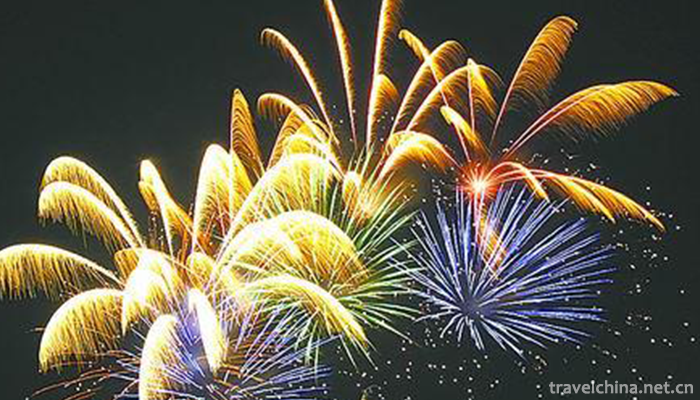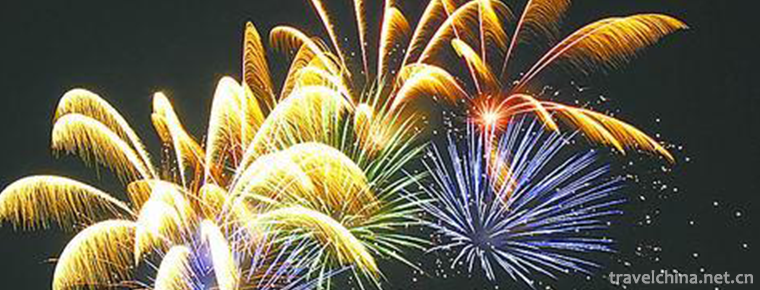Craftsmanship of Fireworks and Firecrackers
Craftsmanship of Fireworks and Firecrackers
Declaration area or unit: Wanzai County, Jiangxi Province
China is the first country to invent gunpowder in the world. Fireworks and firecrackers made of gunpowder also have a long history and enjoy a high reputation in the world. The record of firecrackers originated in Jingchu Sui Shi Ji written by Zongmu of Liang Dynasty in the Northern and Southern Dynasties. The book describes the custom of firing firecrackers in front of the courtyard to avoid evil spirits when chickens crow. At that time, the so-called firecracker actually burned the bamboo tube, causing the air inside the tube to heat and burst and sound. After the Sui and Tang Dynasties, gunpowder was loaded into bamboo tubes instead. In the Song Dynasty, abandoned bamboo tubes were fired with paper wrapped gunpowder instead. Hangzhou, the capital city of the Southern Song Dynasty, has appeared in clusters of small firecrackers, commonly known as "firecrackers". According to the "Old Stories of Wulin", this kind of firecracker rings to the end after it is ignited, "more than a hundred in a row." During the Ming and Qing dynasties, firecrackers developed many patterns, such as double-sounding thunder, three-level wave, two kicks and ten-loud flying. Modern firecrackers have been further developed and perfected in type and technology, forming a complete production system, including single, double, continuous, firecrackers, firecrackers, and other varieties, as well as drums, cutting drums, pasting, mud filling, priming powder, eye sealing and other technology.
Fireworks, also known as "fireworks" and "fireworks", began in the Sui and Tang Dynasties, flourished in the Song Dynasty, and became popular in the Ming and Qing Dynasties. Tang Dynasty has appeared "gunpowder and fireworks" which can present various patterns such as melons and fruits, animals, ghosts and so on. In the Southern Song Dynasty, shelf fireworks were very popular. According to Wan Du Zaji, there were many kinds of fireworks in Beijing in Ming Dynasty. Paper letters were called "flower pots", "clay letters" were called "sand pots". Bamboo basket letters were called "flower boxes". They could show various patterns such as ribbon birds, grape shelves, pearl curtains and long-light lamps. "Jisheng at the age of Emperor Beijing" in the Qing Dynasty said that the fireworks of Jingshi at that time "were packed with stories of numbers in a brocade box, and the characters such as Sheng, Ling feathers and flowers and plants made up their beautiful faces." The color of pyrotechnics is mainly made of gunpowder and different chemical drugs, such as yellow with sodium salt, purple with potassium salt, red with strontium salt, green with barium salt and blue with copper salt.
China's fireworks are mainly produced in Liuyang, Hunan, Wanzai and Pingxiang in Jiangxi, Dongguan in Guangdong, Pucheng and Yangxian in Shaanxi, etc. The shelf fireworks were well-known in the Song Dynasty, but they were seldom used at present. It is urgent to protect and inherit them in order to promote their continued development.
Wanzai County, Jiangxi Province, is a traditional fireworks producing area in China. Since the middle of the 18th century, the local production of fireworks has begun. During the Daoguang Period of the Qing Dynasty, thousands of fireworks and firecrackers had "passed north and south". During the Guangxu period, local "men and women of all sizes took this opportunity to work".
At the end of the Qing Dynasty and the beginning of the Republic of China, there were more and more fireworks practitioners in Wanzai, reaching tens of thousands of people, and there were nearly 1000 fireworks villages. The famous fireworks villages engaged in fireworks management all over the country included Ganzhuang in Ganzhou, Zhejiang and Guangzhuang in Guangzhou. In the 1980s, there were 150,000 employees in the fireworks and firecrackers industry in Wanzai. The products were sold to more than 20 provinces, municipalities, autonomous regions and more than 20 countries and regions such as the United States and Japan.
There are many kinds of fireworks in Wanzai, including all-red salute, large and small cannon, cock gun, thunder gun and so on. In terms of sound, there are 19 kinds of sound, such as six and one hundred; in terms of length and thickness of paper, there are three, four and nine cutting specifications; in terms of knot form, there are flat and vertical (commonly known as "meander"). The raw materials used in the production of Wanzai fireworks and firecrackers are all made locally. The earth paper is core paper. The paper is tender and soft, with toughness, and the quality of powder is excellent. The whole production process from raw material processing to finished product manufacturing consists of more than seventy processes, all of which are operated by hand with high technical content and complex process. Wanzai fireworks products have no impurities and fragrance, high sound rate, clear and pleasant sound, is a favorite for people's Festival celebrations, weddings and funerals, and worship Buddha ancestors.


-
1.Water Margin City Scenic Area of the Three Kingdoms
The Wuxi Film and Television Base of CCTV is the first large-scale film and television shooting and tourism base in China. Founded in 1987, it is the first theme park in China that combines film and t
Time 2018-12-18 -
2.two dragons mountain Erlongshan
Erlongshan is the first national AAAA class tourist area, known as "Harbin East Garden", located 50 km east of Harbin, 127 degrees east longitude 27 minutes 41 seconds, 45 degrees north lati
Time 2018-12-22 -
3.The Ancient City of Gaochang
Gaochang City, which began in the first century B.C., was built by the army of Tuntian in the territory of Cheshi in the Western Han Dynasty. The site of the Old Town is located in the vicinity of Har
Time 2019-01-12 -
4.Guangegou National Forest Park
Guan'e Gou National Forest Park, located in the outskirts of Chang County, Longnan City, Gansu Province, consists of Guanzhugou, Goose Lou Gou, Mulong Gou, Miaogou and other scenic spots
Time 2019-01-13 -
5.Ocean song
Fisherman's chant is the traditional folk song of Zhoushan Islands in Zhejiang Province, which belongs to the general name of the local boat and fisherman's chant.
Time 2019-05-02 -
6.Making Skills of Filament Mosaic
Silk mosaic is one of the traditional handicraft techniques in China. Gold, silver and copper are drawn into silk, and various decorations such as jewelry and utensils are made by various techniques.
Time 2019-05-04 -
7.The 70th Anniversary of the Founding of New China
On January 11, 2019, the Third Plenary Session of the 19th Central Discipline Inspection Committee of the Communist Party of China opened in Beijing. Xi Jinping, General Secretary of the CPC Central
Time 2019-05-04 -
8.Eighteen General Martial Arts
A traditional term of Chinese Wushu, also known as "Eighteen Weapons" and "Eighteen Weapons", is commonly used in ancient Chinese operas and novels, referring to the use of various
Time 2019-06-15 -
9.Tan Zhenshan Folk Stories
Tan Zhenshan family has a tradition of "telling stories and telling ancient times". Some elders in the family are good at telling stories. Many stories have been passed down in their family
Time 2019-06-18 -
10.Xingshan Folk Song
On May 20, 2006, Xingshan Folk Song was approved by the State Council to be included in the first batch of national intangible cultural heritage list.
Time 2019-07-08 -
11.The Story of the Hundred Birds Clothes of the Zhuang Nationality
At the beginning of liberation, Guangxi was a remote part of China at that time, but the appearance of Hundred Birds'Clothes showed that Guangxi was not a barren place for literature, and the minority
Time 2019-08-16 -
12.Topography and geomorphology of Suining
Suining is a hilly and low mountain area in the central part of Sichuan Basin, with simple geological structure and gentle fold. The landform type is single, belonging to the Mesozoic Jurassic strata, which is eroded, cut and accumulated by flowing water
Time 2020-12-16